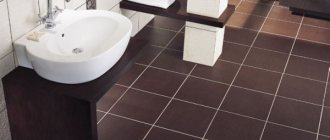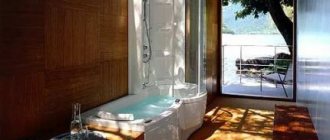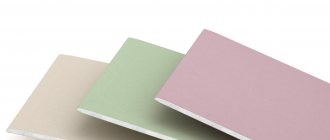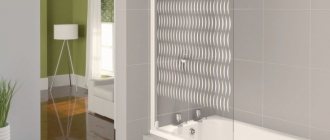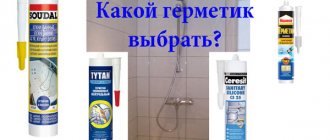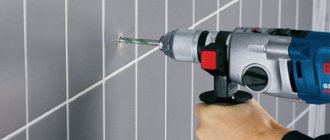In this material we will tell you how to choose tiles for a bathtub, what to pay attention to first, and also show ready-made ideas for stylish and practical interiors for every taste and budget. After all, tiling a bathroom is a responsible and important task. Despite the fact that the average person spends no more than 1 hour a day in the bathroom, its decoration must be approached thoroughly, since high-quality and stylish renovations directly affect the mood of the household and their comfort. A bathroom is a place where a person can not only get themselves in order, but also relax after a hard day, so tiles for the bathroom must be chosen carefully so that they meet the technical characteristics of the room, fit organically into the overall design of the room and are “pleasing to the eye.” all family members.
How to choose tiles for a bath?
Choosing material
When choosing ceramic tiles for the bathroom, you need to take into account the composition and moisture-resistant parameters of the material. Blocks are divided into ceramic, glass, porcelain stoneware. Collections are produced for floor surfaces, walls, sets with accessories in a single color scheme.
For tiles in bathrooms and toilets, the following are important:
- resistance to abrasion and mechanical stress;
- ability to withstand temperature changes;
- strength;
- resistance to cleaning agents with acid-base composition;
- durability;
- color fastness, preservation of the geometry of ornaments;
- anti-slip characteristics;
- low water absorption (10-15%).
Ceramic tile
Ceramics for the bathroom are aesthetically pleasing, strong, durable, and budget-friendly. Finishing blocks differ in purpose, manufacturing technology, composition, design, and color schemes.
Clinker blocks are the most durable, moisture-resistant, resistant to temperature changes, and easy to clean.
The material has a matte texture and is available in a range of natural brown and reddish shades. The collections feature imitations of brick, wood, and products with aged surfaces.
Glazed slabs are moisture-resistant, durable, allow you to create original ornaments, and are distinguished by glossy surfaces and rich shades.
Cotto slabs are made of red clay and are not glazed. When installed in a bathroom, the blocks must be treated with a hydrophobic compound to preserve the porous surface.
Monocottura slabs are used to finish the walls and floors in bathrooms. The products are distinguished by rich shades and decorative patterns.
Bicottura ceramics are distinguished by natural, dusty shades, suitable for decorating bathtubs in classic, Provence, and country styles. The product is optimal for wall finishing; the material is not dense enough for flooring.
Glass tiles
Glass slabs are aesthetic, moisture-resistant, durable, and hygienic. The material is used to create color accents in a room and can be combined with tiles, wood, polymers, and metal. Glass blocks can be frosted or transparent and are available in different sizes.
The material can be tinted, complemented by engraving, artistic painting, and ornaments.
Thin glass blocks are not recommended for laying on the floor; the coating is not wear-resistant and stable enough.
The elements are used to create complex mosaic installations.
Glass inserts make small bathrooms appear larger. The slabs can be laid diagonally, in a checkerboard pattern. The wall decoration can be solid or combined with monochrome tiles. The material is durable, easy to clean, and resistant to corrosion and mold.
Porcelain tiles
Porcelain stoneware slabs are the most durable, wear-resistant, and durable.
The materials are recommended for finishing floors and walls in spacious bathrooms in residential and public spaces.
The plates are resistant to abrasion and chipping. Manufacturers offer a wide palette of natural shades with matte and glossy textures. In terms of homogeneity of composition and resistance to changes in temperature conditions, the material corresponds to stone rocks. The boards are easy to clean and resistant to plaque and mold.
Compatibility with heated floors
The floor in the bathroom, lined with ceramic tiles or porcelain stoneware, feels cold. It is unpleasant to stand on it after lying in a warm bath or taking a contrast shower. You can get out of this situation by laying down a fluffy rug. But you can solve the issue radically - install a heated floor in the bathroom. In addition to a comfortable feeling of warmth, this option will help to avoid the following troubles: dampness, mildew and mold. In this case, it is necessary to choose a tile that will be able to withstand temperature changes without collapsing. And at the same time it will not become a heat insulator. It should transmit heat, and not suppress thermal radiation.
Currently reading: Bathroom design in pink colors: 50 chic ideas
Determining the dimensions
When choosing a bathroom coating, the shape and size of the blocks are important. Manufacturers produce slabs of standard and non-standard dimensions. The list of popular ones includes rectangular slabs 100x100, 150x150, 300x300, 75x150 mm.
To create glass inserts, square elements 65x65, 100x100 mm are used. Mosaic installation is carried out with slabs of 10x10, 20x20, 20x40, 30x30, 48x48 mm.
In a small bathroom it is recommended to install medium-sized blocks, because... mosaic elements visually narrow the room. The optimal size of square blocks is 20x20 cm, rectangular - 20x30 cm.
In the design of large rooms, slabs of different sizes and configurations can be used.
How to check tiles when purchasing
To check the quality of the tiles, take 2 pieces and place them with their side edges facing each other. Then place one tile on top of the other. In both cases there should be no visible gaps with a tight, continuous fit. After this, measure several products with a tape measure and the dimensions should not differ by more than 1 mm.
To check the strength, ask the seller for a split copy and try to break it. It's unlikely to be possible to do this by hand. Carefully inspect the tiles for defects. It is worth checking as much material as possible.
Choosing a style
Before choosing tiles for your bathroom, you need to determine the style of the room. The color scheme, decor, type of installation and size of the slabs are selected for the design.
Popular trends in bathroom interior design:
- classic;
- Provence;
- loft;
- minimalism;
- country;
- high tech.
Classic
Classic design is universal and aesthetic. The standard option involves finishing the upper part of the wall with slabs of light shades, the lower tier is filled with cladding 2-3 shades darker. The area where the surfaces join is decorated with border tiles with geometric patterns. The flooring is decorated with slabs of dark shades. A light floor finish will visually expand the room.
To implement a classic design, natural materials are recommended (ceramic granite, marble, glazed blocks). The interior color scheme includes white, dark brown, pastel and beige colors. Geometric patterns complement the monochromatic palette.
During installation, parquet laying techniques, “herringbone”, and “checkerboard” are used. The interior is complemented by bronze-decorated bathtubs, candlesticks, and taps. Bronze-plated inserts can be included in wall slab installations.
East style
The eastern direction of design is distinguished by the use of bright colors in decoration. The style involves the use of slabs with elegant ornaments (stylized flowers, birds, Turkish cucumber). The decoration combines slabs of rich blue, golden, dark green, red, bright blue, and yellow.
The oriental style is distinguished by the inclusion of mosaic decor when decorating walls, ceilings, floors; patterns also decorate equipment (bathtub, sink, stands). The decor is optimal for spacious rooms.
It is not recommended to carry out continuous mosaic laying in rooms with a combined bathroom.
Small bathrooms are decorated with medium-sized slabs, and the decoration is complemented with ornamental inserts.
Provence
To implement a bathroom project in a Provençal style, you need to use the following shades:
- lilac;
- lavender;
- beige;
- olive;
- baby blue;
- citric.
White or milky plaster is recommended as a background for the slabs. The surfaces of the plates can be glossy, matte, textured. In addition to plain elements, the installation includes blocks with floral patterns, aged surfaces, decoupage, engraving, and wood stylization.
The slabs are decorated with images of compact bouquets, rural scenes, herbs, and flowers.
Minimalism
Bathroom design in a minimalist style involves the use of restrained colors. For finishing, blocks of standard sizes, monochrome or with inclusions of geometric patterns, are used.
Laying is carried out according to classical schemes. A combination of 2-3 shades in the interior is allowed. Optimal matte surfaces are included in the finishing of slabs imitating natural wood.
Loft
To decorate a loft-style bathroom, tiles imitating the texture of brick, concrete, and metal surfaces are used. The inclusion of blocks with the effect of aged surfaces is popular.
Industrial style involves combining surfaces with different textures. Several walls are decorated with brickwork, the partition can be stylized with metal slabs.
Restrained surface shades (gray, beige, white) can be complemented by slabs with street art drawings in bright colors, reproducing graffiti, and spectacular posters.
When implementing the project, the stylization of unpainted plaster and aged brickwork is used. The flooring is laid with porcelain stoneware blocks symmetrically or with a slight offset.
The design of a loft-style bathroom may include blocks stylized as untreated wood. The slabs must be large in size to create the effect of a plank floor.
What does the thickness of the tiles on the wall affect?
I repeat, the thicker the tile, the greater its weight. Therefore, you need to pay attention to the thickness of the tiles:
Firstly, if you have a weak base for laying tiles. For example, the wall is made of plasterboard or lined with gypsum plaster that is questionable. Using thick and oversized tiles on such walls can lead to the tiles slipping or tearing off. For such bases, the optimal tile thickness is 6-7 mm.
Secondly, the tiles are laid on an uneven base. In this case, the wall will be leveled with a layer of tile adhesive. As a result, its weight will increase. If you add the heavy weight of thick tiles to the heavy weight of the adhesive, the same problems of tiles slipping and tearing off may appear.
Thirdly, there is a direct connection between the thickness of the tiles and the choice of tile adhesive. For thick tiles, a special adhesive is selected, which should be read on the packaging.
It is worth noting that there is no connection between the thickness of the tile and the choice of notched trowel. The size of the tile trowel teeth depends on the size of the tile, not its thickness. The same applies to the choice of thickness between the tile joints.
Choosing a color
When selecting the color scheme of a room, the dimensions, style direction, and location of plumbing equipment are taken into account.
Neutral slabs of white, milky, and ivory colors are universal in bathroom design. The design solution is recommended for compact spaces, because... will visually enlarge the room. Monochrome blocks can be combined with bright decorative elements with ornaments.
A classic color scheme is a room decorated in blue tones. The design uses slabs of turquoise, blue, and purple shades. Slabs of white and silver shades will set off the rich colors.
A popular design solution is a bathroom in green tones. When laying, slabs of light green, pistachio, emerald, and malachite shades can be combined. You can complement the design with elements of beige, white, and sand shades.
The bathroom, decorated with slabs of burgundy, red, lilac, violet shades, is complemented by white and pastel elements. Combinations of pink and crimson shades with fuchsia inserts look impressive. Surfaces can be matte or pearlescent.
Finishing the walls and floors with slabs of coffee and beige shades helps create a comfortable environment. The design is complemented by the inclusion of solid wood imitation blocks. Bright accents can be created by including golden, turquoise, terracotta colors.
The classic option is the combination of white and black. The finish can be complemented with chrome elements and inserts of silver mosaic tiles.
Small bathroom decor with tiles
In order for the interior design to be more attractive and interesting, it is important to choose decor, which can serve as:
- Mosaic (glass, metal or contrast).
- Tile with a relief texture imitating fabric, brick or stone.
- Tiles with a pattern.
- Mirrors.
- Frieze and borders.
- Grout matching the color of the tile.
- Gold and silver inserts.
Deciding on the surface
When deciding which tile is best to choose for the bathroom, you can determine the texture from the photo.
Floor slab coatings for rooms with high humidity must be safe, with an anti-slip effect.
According to the appearance of the product there are:
- matted;
- glossy;
- textured (with imitation of stone, untreated wood, pebbles, metal).
Glossy tiles
Slabs with glossy surfaces are often used in bathroom decoration. Special compounds are applied to the blocks, which after heat treatment provide strength to the products. The coatings are easy to maintain, reflect glare of light, and visually expand the space. Glossy products are available in a wide range of bright and pastel shades.
However, it is necessary to take into account the instability of smooth surfaces; blocks are not recommended for floor finishing. The material is used in the design of walls, ceilings, and furniture.
Matte tiles
Boards with a matte surface are not subject to additional processing or glazing.
The advantage of the products is their rough texture, which ensures safe operation in rooms with high humidity.
Mineral chips are applied to some blocks, giving the coating a shimmering shine.
The products are more durable, reliable, wear-resistant, and can withstand mechanical loads. However, it is necessary to take into account the greater moisture absorption of the porous surface.
The color range of matte products is neutral, dusty, the blocks are optimal for laying out the background for collages and mosaics.
Mirror tiles
Mirror plates are decorative, moisture resistant, and easy to clean. The material allows you to visually expand the bathroom space. Plates are used to decorate solid surfaces (ceilings, walls) or combined with monochrome blocks. Using large elements, you can mount the mirror on the wall.
A diagonal layout on the walls and flooring will visually lengthen the space. Installing mirror material on the ceiling will visually increase the height of the room.
Matte or glossy
Most experts will tell you - definitely matte. She looks more natural and noble. And gloss is an excessive shine that has already gone out of fashion.
But, of course, there are always exceptions. For example, if the tile you choose imitates natural marble, then this material should a priori shine. Therefore, there will be an option with a glossy finish. Although, most likely, this will be the only option, since few manufacturers make matte marble. The same goes for mosaics. This type of tile also implies shine, and therefore the surface will be glossy.
There is another finishing option that exactly imitates other materials. Among them are wood, metal, stone, marble. And here the approach may be different. For example, to imitate wood or stone, it is better to choose a matte surface. But marble or metal should a priori shine. And accordingly, gloss looks more preferable here.
Choosing a laying method
Before choosing tiles for the bathroom and toilet, you need to determine the method of laying the material. In accordance with the method, square, rectangular or polygonal products are required. The design influences the selection of glue, plaster, and grout.
Installation of slabs is carried out:
- diagonally;
- brickwork;
- "herringbone";
- mosaic;
- "kaleidoscope".
The finishing can be done using single-color blocks or supplemented with inserts with ornaments, painting, and engraving.
Brickwork
Laying under a brick wall is used in different design directions (country, loft, modern, classic).
Finishing one surface in monochrome will visually expand the room and create a cozy space.
Brickwork is popular in antique-style rooms. It is possible to combine brick-like slabs and a plastered surface in a classic style. In vintage interiors, brick blocks can be combined with smooth tiles.
Easy installation
Basic installation is the easiest to perform. The method is optimal for floor design and does not involve displacement of elements. A symmetrical layout of elements requires leveling the floor surface.
During installation, experts recommend using large slabs; it is possible to include contrasting elements. When finishing a compact bathroom, installation is done using medium-sized slabs.
Diagonally
Diagonal laying is aesthetically pleasing, visually lengthens the room, and is advantageous in monochrome interiors. During installation, a diagram and calculation of the material, surface marking, and adjustment of elements are required.
The laying method allows you to hide uneven perimeter and surface imperfections. The design is recommended for flooring in classic, modern, and baroque interiors.
Herringbone
The herringbone layout is used in the design of floor surfaces, but is not recommended for walls. For the bathroom, choose porcelain stoneware or ceramics with wood, stone or plain finishes.
For finishing, elongated rectangular slabs are used. It is possible to use blocks of several shades and sizes.
Wood-look boards will create an imitation of parquet; the method is optimal for spacious rooms. It is possible to include inserts with ornaments in vintage-style rooms.
Mosaic
Mosaic tiles allow you to implement complex design solutions indoors. The material is strong, moisture-resistant, durable, and can withstand high temperatures.
Blocks are produced in different shapes, sizes, and colors. Plates are produced in the form of squares, rectangles, circles, rhombuses, and polyhedra.
Blocks are used to create accents on walls, flooring, and interior items. The small dimensions of the products allow installation on uneven surfaces and curved planes.
It is possible to create ornaments and artistic images. Complex installation of products must be taken into account.
Which tile should you not choose?
It is known that some of the tiles on sale are outright defective. You can only buy them for finishing a garage or cellar, but you can’t buy them for a bathroom.
It is also better to avoid small square ceramics. It looks too out-of-date, and the number of seams is clearly prohibitive. An exception may be material with a printed pattern.
You should not buy tiles that are too cheap. A low price indicates either a defect or low quality, and possibly a small balance in the warehouse.
Why shouldn't you use borders?
When decorating modern interiors, borders are not used. The elements were used for rooms with a standard height. In modern residential complexes, ceiling heights vary and adding a decorative insert of 5 cm can lead to asymmetrical laying of the main blocks.
In rooms with suspended ceilings, the height is adjustable; when laying slabs, you can trim elements and not add borders.
Experts do not recommend using borders to separate light and saturated backgrounds, because... If the horizontal line is not observed, the repair will turn out to be unaesthetic. A narrow insert may not fit the overall design of the room. Additional joints can lead to deformation of the coating and disruption of the composition.
Quantity calculation
It is very important! If you take less, then there may not be any left in the store. And if you take more, the excess may not be accepted back.
Tiles are usually sold in boxes. And decorative elements - individually. To make the task easier, you can use a construction calculator. But experts advise adding about 10 percent more to the resulting volume. This is necessary to compensate for defects and residues when cutting the tiles.
Choosing a manufacturer
In the ranking of popular companies producing bathroom tiles, domestic and foreign manufacturers:
- Kerama marazzi;
- Cersanit;
- Fap ceramiche;
- Unitile;
- Keramin;
- Golden tile.
Kerama marazzi
The Kerama Marazzi company offers collections of ceramic products, porcelain stoneware blocks with different textures, shades, and patterns. The company also produces product lines with imitation of solid wood of different species, brickwork, stone, and genuine leather. The products in the collections are monochrome, with ornaments and paintings.
Cersanit
The manufacturer Cersanit produces more than 20 collections of porcelain stoneware blocks and about 30 selections of ceramic tiles for bathrooms. Blocks are presented with glaze, matte, with textured images, in bright and pastel shades.
The company produces a comprehensive line of products for bathroom design. Products are manufactured using European technologies and are certified.
Unitile
The Unitile company produces about 30 collections of ceramic tiles for bathroom decoration. Popular block sizes are 33x33, 60x60 cm. The collections feature universal products in different shades. Products are high quality and affordable.
Fap ceramiche
The Fap Ceramiche company (Italy) specializes in the production of slabs for bathrooms and offers customers more than 30 collections. The company produces environmentally friendly products from natural ingredients that feature an original design.
The line includes blocks with imitation of precious woods and stones. The products are distinguished by their quality, resistance to abrasion and ultraviolet rays, and do not lose color brightness.
Golden tile
The Golden tile company (Ukraine) presents budget and mid-price collections. The enterprise has a raw material procurement base, a design bureau, and uses modern technologies (digital printing). The company's product range includes more than 60 collections of slabs. Standard sizes are represented by blocks of 20x30, 25x40, 30x60, 15x60, 30x30, 40x40 cm.
Keramin
sells products in the mid-price category. Buyers are offered more than 80 collections (“Venice”, “Tokyo”, “Sakura”, “New York”). There are several color solutions for ornaments and graphic designs.
The manufacturer offers slabs with landscape images. The products are durable and wear-resistant.
Classification of tiles by size
Based on size, ceramic tiles are divided into 4 groups:
- Mosaic: the most compact - ranging in size from 1x1 cm to 5x5 cm. Often produced in blocks of several pieces, mounted on a base made of a polymer mesh.
- Small: this class includes square tiles with sides ranging from 6x6 cm to 20x20 cm and rectangular tiles with a length of no more than 30 cm. The most popular modules are 15x15 cm and 20x20 cm in size.
- Medium: square modules have sizes from 20x20 cm to 30x30 cm, for rectangular ones the side length does not exceed 40 cm. From this category, tiles of sizes 20x30 cm, 25x30 cm and 25x35 cm are most often used.
- Large: any tile with a side length exceeding 40 cm is considered as such.
Construction supermarkets often resort to a simplified classification:
- with side lengths up to 30 cm: small format;
- up to 50 cm: medium;
- more than 50 cm: large.
Rectangular tiles with an aspect ratio of 2:1 - 3:1 are gaining popularity, for example, 25x60 cm, 30x90 cm, 29x100 cm.
How to make an unusual floor?
When implementing a bathroom project, you can create an unusual floor covering. Experts offer options for finishing with solid wood, honeycomb-style installation, complex mosaic patterns, and stone stylization.
Under the tree
Natural wood is not used to decorate the bathroom floor due to the material’s instability to high temperatures and high humidity. However, you can reproduce the imitation of laying boards using ceramic products.
The materials are budget-friendly, environmentally friendly, durable, easy to care for, and moisture resistant. The slabs are made with imitation of different types of wood.
When laying, it is important to observe the direction of the fibers of the rocks. In accordance with the style of the room, parquet equipment is selected, installation of slabs stylized as deck boards, “Versailles”, “4 species” weaving.
Wood-look flooring is optimal for minimalist, country, and Provence styles.
Honeycomb
Flooring using the honeycomb technique involves the use of hexagonal-shaped blocks. The original configuration of the elements is optimal in a monochrome interior.
With the help of elements, the space is visually united, smooth transitions of shades and textures are created, and original drawings are created. Hexagonal blocks can be decorated with ornaments, reproducing the texture of marble, parquet, and concrete. Laying can be done in fragments.
Mosaic
Mosaic slabs are moisture-resistant, durable, can withstand high temperatures, and are the optimal design solution for the bathroom. This type of masonry can be implemented on uneven surfaces, in hard-to-reach areas of the bathroom, at wall joints, and corner elements.
The use of special fasteners (chips) allows you to create complex artistic images, ornaments, and create accents using color.
In spacious rooms, mosaic finishing is possible on large surfaces. In compact rooms, it is recommended to include images in monochrome masonry.
Depending on the design project, mosaic slabs made of ceramic or glass are used, installation is carried out according to traditional patterns using moisture-resistant glue, and the seams are treated with a primer.
Manufacturers offer ready-made layouts on mesh or rubber bases, which are glued to the prepared surface.
The mosaic is made in different styles (modern, classic), can be stylized as antique, or complemented with blocks with a worn effect.
Stone
Floor decoration with stones is used in classic interiors, when creating bathrooms in Baroque and Rococo styles. The coating is durable, wear-resistant, and aesthetically pleasing.
Experts recommend using marble slabs that are resistant to humidity, mechanical stress and thermal influences. It is not recommended to use slabs with metal inclusions in bathroom decoration due to the risk of rust formation.
It is necessary to take into account the high price of raw materials and the need for polishing using special means. An alternative option is to lay slabs under stone. Many manufacturers include marble, onyx, and granite products in their collections. With proper installation, you can reproduce the fibers of rock.
Form
In addition to sizes, the shape of the tiles is also available in a variety of options:
- square in the bathroom - a classic option; with its help you can lay out the pattern with diamonds, lay out a diagonal pattern or lay it out in a checkerboard pattern;
- rectangular in the bathroom - allows you to visually change the size of the room: vertically laid tiles visually raise the ceiling, and horizontally placed tiles push the walls apart;
- hexagonal - a design novelty, externally imitates a honeycomb; The tiles that are laid up to the middle of the wall look original;
- diamond-shaped, oval and round tiles - the unusual shape dictates a special installation technology - the kit includes elements that fill the gaps between the elements.
Examples in the interior
Main characteristics of tiles
After familiarizing yourself with the main characteristics, it will become clear which tile is best to choose for the bathroom.
The range of collections is varied in shades, sizes and prices.
- Porosity. It is determined by the amount of air in the product. The higher this indicator, the more wear-resistant and durable the tile. Also, with low porosity, the amount of moisture that can get inside is minimal. The product will be resistant to cold and frost.
- Frost resistance. Talks about the possibility of using tiles outdoors. Indicated by a snowflake icon.
- Wear resistance. Determines the duration during which the tile will retain its beautiful appearance and will not be susceptible to scratches.
- Chemical resistance. Shows how a material can withstand washing with cleaning agents. There are five classes: persistent (AA), persistent (A), moderate loss of quality (B), partial loss of quality (C) and unstable (D).
The tiles are ideal for finishing wet rooms due to their physical properties.
What color of tiles to choose for the bathroom: a good combination
You can choose absolutely any color scheme for the bathroom. An important criterion is the taste of the buyer. The most win-win and popular option is a white shade. It is easy to combine with any other bright shades. It is also able to visually enlarge the room.
Resistance to moisture, high strength and aesthetics are the main qualities that are valued when decorating bathroom walls with this material.
Pastel shades such as beige and pale pink can be used if white seems out of place or too formal.
Optimal solutions will make a miniature room more spacious.
Follow the rules for making the right choice.
- Lighting affects surface shades, and this is important.
- Glossy tiles create glare, which is not everyone’s cup of tea.
- Tiles with a vertical pattern visually increase the height of the room.
- Tiles with large prints and dark shades are not suitable for small rooms.
This effect is achieved not only due to the color and shape of the finishing material, but also using the layout method.
Tile surface and texture
Glossy. It creates a pleasant atmosphere and comfort in the room. Caring for such a surface is a painstaking and difficult task. Hard water leaves stains on the gloss, the shine fades and loses its attractiveness.
The diagonal-modular layout of elements on the floor allows you to visually enlarge a small room.
Optimal application of gloss.
- In small areas.
- In bright and well-lit interiors.
- In bathtubs that are not used often. This does not require frequent cleaning.
Soft light allows you to relax during water procedures.
Matte. Such tiles are very relevant nowadays. It is textured, very practical and adds volume to the room.
The cladding occupies the maximum surface of the bathroom, the furniture is in harmony with the main background.
Main advantages.
- Original spectacular appearance.
- The level of practicality is many times higher than glossy ones.
- Pleasant to the touch material.
- There is no cooling effect inside the room.
- Resistant to mechanical stress.
- Looks good, even in low light.
- High level performance characteristics.
Despite the variety of textures and varied tile designs, the room is perceived as one.
This type is often used when covering the floor. It is also effective for walls. It is used in various design styles, such as classic, retro, Provence, etc.
The main secret is that the shades are located next to each other on the color wheel.


